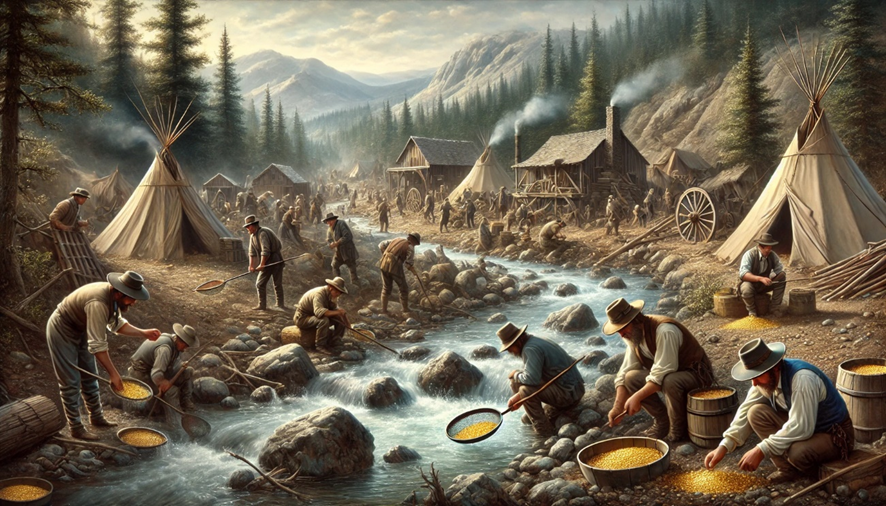The Gold Rush
The gold rush was a historical phenomenon that profoundly impacted several regions of the world during the 19th and 20th centuries. Triggered by the discovery of gold deposits, these events drew thousands of people in search of quick riches. The gold rushes not only reshaped the economies of the affected territories but also transformed their societies, landscapes, and cultures, leaving a lasting legacy.
Context: Gold as a Symbol of Wealth
Since ancient times, gold has been a universal symbol of wealth and power. Its rarity and resistance to tarnish made it valuable as currency and a coveted asset. However, it was in the 19th century that gold triggered massive migrations, known as "gold rushes," which altered global dynamics.
The first major event of this kind was the California Gold Rush in 1848, sparked by the discovery of gold nuggets at Sutter's Mill near Sacramento, USA. The news spread rapidly, attracting people from around the world, including from America, Asia, and Europe. Similar phenomena occurred elsewhere, such as in Australia (1851), South Africa (1886), and the Klondike in Canada (1896), each with its own unique characteristics and consequences.
The Race for Gold
The discovery of gold in any region triggered a wave of mass migration. Farmers, artisans, and merchants abandoned their homes, driven by hopes of a better life. For instance, the California Gold Rush attracted around 300,000 people between 1848 and 1855. Many crossed oceans or deserts, enduring great sacrifices in their quest for fortune.
Life in the goldfields was harsh. Prospectors, known as forty-niners in California, worked long hours in rivers and mines, facing diseases, theft, and territorial disputes. Only a few struck it rich, while the majority encountered disappointment and, in many cases, financial ruin.
As news of gold discoveries spread, makeshift settlements quickly emerged, often evolving into cities. San Francisco, for example, transformed from a small village into a major commercial hub within a few years. These urban centers were marked by chaos and a lack of regulation, where disputes over land and mining rights were commonplace.
Social and Economic Impacts
Gold rushes not only transformed local economies but also had profound effects on indigenous communities. In California, for example, the massive influx of gold seekers displaced and decimated native populations due to violence, disease, and the destruction of their lands.
The gold extracted fueled international monetary systems, increasing the wealth of nations that controlled the deposits. However, gold rushes also left a legacy of inequality. While large mining entrepreneurs profited greatly, small prospectors rarely achieved economic stability.
In places like Australia and South Africa, gold rushes were catalysts for political and social change. In Australia, they encouraged mass immigration and contributed to the formation of a national identity. In South Africa, the discovery of gold in the Witwatersrand in 1886 turned the region into the epicenter of global mining but also exacerbated racial and social tensions that culminated in apartheid.
The Decline and Legacy of Gold Rushes
Over time, the most accessible deposits were exhausted, marking the decline of gold rushes. Mines began to be exploited by large companies with heavy machinery, leaving independent miners behind. Settlements that failed to diversify their economies became ghost towns.
Despite their decline, gold rushes left a significant impact. Cities like San Francisco, Melbourne, and Johannesburg flourished due to the gold boom. Additionally, gold discoveries spurred technological advancements in mining and transportation, such as the use of railroads to connect mines with ports.
Culturally, these mass migrations also left their mark. Stories, songs, and legends about the pursuit of gold became part of the folklore of many societies, solidifying gold as a symbol of ambition, perseverance, and, often, greed.
Lessons from the Gold Rush
The gold rush is a reminder of how the quest for wealth can profoundly reshape societies. This phenomenon highlights humanity’s ability to mobilize en masse for the promise of fortune but also underscores the environmental, social, and economic costs that often accompany such events.
While gold remains valuable today, parallels can be drawn with other "booms" in recent history, such as financial or technological bubbles. Just as in the 19th century, the pursuit of quick wealth remains a powerful driver of human action but also a source of significant risks.

